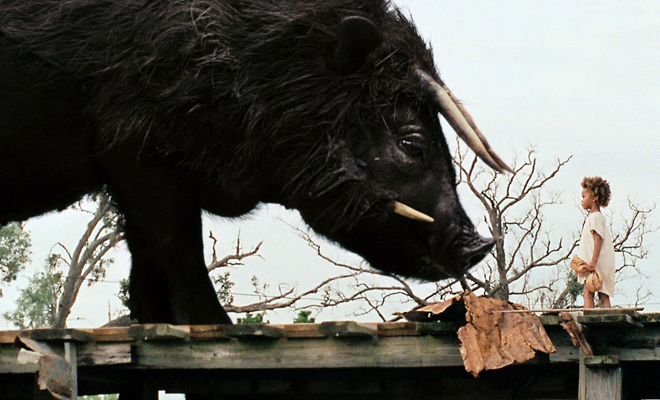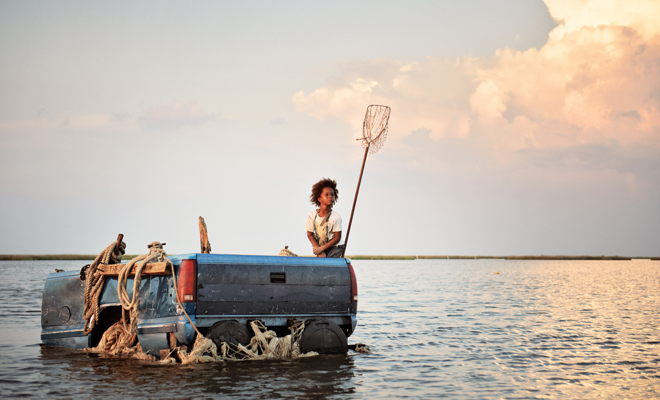A Mantra for New Orleans: Beasts of the Southern Wild

Quvenzhané Wallis as Hushpuppy on the set of Beasts of the Southern Wild. Courtesy of Fox Searchlight Pictures.
Yes we'll walk with a walk that is measured and slow, / And we'll go where the chalk-white arrows go, / For the children, they mark, and the children, they know / The place where the sidewalk ends. — Shel Silverstein, from “Where the Sidewalk Ends”
“I want to be cohesive.” Spoken first by a salty boat captain, the phrase is parroted a moment later by Hushpuppy (played by Houma, Louisiana native Quvenzhané Wallis), the star of Benh Zeitlin’s 2012 film, Beasts of the Southern Wild. It’s an odd sentiment for a child, but for this precocious young heroine, finding a way to be whole, to put together all the pieces, is what it’s all about. Shot on 16mm on location in Southern Louisiana, Beasts of the Southern Wild is Zeitlin’s first feature length film. Though Beasts is not necessarily a story about Hurricane Katrina and the failure of New Orleans’ levees, for residents of the region it conjures tragedies that will never be forgotten, when their worlds were torn apart. What most distinguishes this film from the plethora of fiction and non-fiction produced in the wake of the storm is that it intentionally resists the tropes of documentary storytelling. Part fairytale, part dreamscape, Beasts relies on the language of poetry and the methods of rhyme with phrases that are repeated like a chorus and imagery that returns as apparitions. Bringing to mind references as disparate as Shel Silverstein’s poem, “Where the Sidewalk Ends” (published in 1974) and the 1995 French film, La Cité des enfants perdus (The City of Lost Children) directed by Marc Caro and Jean-Pierre Jeunet, Beasts of the Southern Wild is a fantasy as much as it is a nightmare.
Though visually different in nearly every possible way, Beasts of the Southern Wild shares some key concepts with The City of Lost Children. Both films take place in fictionalized, post-apocalyptic landscapes surrounded by polluted water. Both dance gently around Surrealistic imagery and embrace elements of magic realism. And most importantly, dreams—specifically those of children—are central concerns. In The City of Lost Children, a mad scientist of sorts has devised a method for extracting children’s dreams (since he’s a soulless being, incapable of having his own), while in Beasts of the Southern Wild, Hushpuppy’s dreams evaporate as each day passes. Her fears and visions are precious not only because she retains a child’s sensibility, but also because she is an artist, a dreamer, a person who believes she must somehow leave her mark. In the sequences when Hushpuppy feels most alone, she retreats from reality and makes rudimentary drawings in an attempt to make sense of it all. Even the strange mythical creatures known as aurochs that emerge from time to time, appear to be under Hushpuppy’s spell, simply characters populating her imagination.
Throughout the film, Hushpuppy’s father, Wink (played by New Orleans resident and bakery owner Dwight Henry) brusquely schools her on the ways of the world as he slowly accepts his impending death. Though his lessons are well intended, the knowledge he imparts replaces the magical ruminations of her childhood with the realities of adulthood. Miette, the ingénue of The City of Lost Children seems to understand things in much the same way as Hushpuppy. Both are a bit jaded, old beyond their years, yet still clinging to remnants of innocence. “You’re born in the gutter. You end up in the port,” Miette laments when facing her potential demise alongside her friend and mentor One. It’s easy to imagine Hushpuppy embracing the rural equivalent. Both Hushpuppy and Miette have been forced to grow up fast and stand strong alongside older male role models who help them brave their peculiar worlds.
In contrast to the majority of post-Katrina material that focuses on the inhumanity of the situation such as Douglas Brinkley’s The Great Deluge or Spike Lee’s When the Levees Broke, Beasts of the Southern Wild does the opposite. Firsthand accounts and brutal honesty were what was needed in the months and years immediately following the chain of events that permanently altered the Gulf Coast, and in particular New Orleans. Seven years later—though the memories have not faded—Beasts provides a profoundly different perspective. By addressing catastrophe through the eyes of a child, the film articulates how very human we really are. As Hushpuppy proclaims in a voiceover: “The whole universe depends on everything fitting together just right. If one piece busts, even the smallest piece, the entire universe will get busted.” This holistic worldview is a far cry from Hushpuppy’s life in the Bathtub, the narrow strip of land where she lives. Literally cut off from the rest of the world by a levee, the inhabitants of the Bathtub make the most of their shrinking corner of the earth. They exist in a place where sidewalks really do end. Like the sidewalk of Silverstein’s poem, the Bathtub is also a means of escape. In spite of unspeakable poverty, it’s a utopia compared to the ugliness of the industrial and chemical plants that loom in the distance. It’s a place where all things big and small are somehow harmonious.

Quvenzhané Wallis as Hushpuppy on the set of Beasts of the Southern Wild. Photo by Jess Pinkham.



